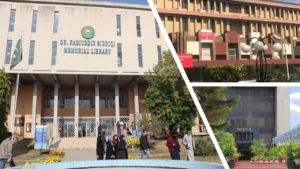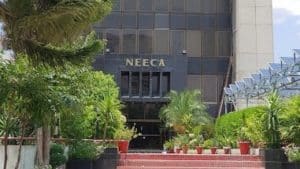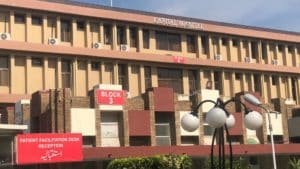As recently demonstrated by three pilot projects in Pakistan, implementation of new lighting regulations and green procurement practices to accelerate the uptake of high-efficiency LED lighting technologies and smart controls (e.g., occupancy sensors and street lighting dimming controls) offers one of the single biggest opportunities to quickly realize immediate energy savings and greenhouse gas (GHG) emissions reductions.
 Pakistan has been actively working to achieve these benefits since February 2019 with the launch of the Global Environment Facility supported national market transformation programme, Delivering the Transition to Energy Efficient Lighting in Residential, Commercial, Industrial, and Outdoor Sectors.
Pakistan has been actively working to achieve these benefits since February 2019 with the launch of the Global Environment Facility supported national market transformation programme, Delivering the Transition to Energy Efficient Lighting in Residential, Commercial, Industrial, and Outdoor Sectors.
The project, jointly implemented by the National Energy Efficiency and Conservation Authority (NEECA) as the federal focal authority and the United Nations Environment Programme’s United for Efficiency (U4E) initiative, aims to secure significant global climate change mitigation and environmental benefits by instituting energy-efficient lighting in Pakistan by transforming the lighting market to highly energy-efficient and quality lighting products.
It achieved its first major milestone in December 2020, when new mandatory minimum energy performance standards (MEPS) for energy efficient LED lighting came into force in Pakistan, supported by a 5-star energy labelling scheme.
To showcase the energy, environmental and financial savings that can be achieved by meeting, or exceeding, these MEPS, the project included the design, installation, monitoring and evaluation of lighting demonstration projects in high profile government buildings as part of its scope of work. These pilot projects serve to increase awareness and give confidence in the benefits by direct user experience and demonstrate a robust methodology for LED retrofit projects. This included:
- An initial lighting audit to determine the existing inventory of lighting fixtures and any potential mechanical issues that could delay or prevent the lamp’s replacement for LED technology, and the calculation of a baseline for the quantification of the upcoming energy savings
- Procurement of the required replacement products. Wherever possible this was carried out in line with U4E’s Green Public Procurement Technical Guidelines and Specifications for Energy-efficient Lighting
- Installation and monitoring of performance
- Calculation of project impact
The three small-scale pilot deployments were undertaken at the:
- National Energy Efficiency and Conservation Authority (NEECA) Office Building
- Quaid-i-Azam University´s Library
- Capital Hospital
 The pilot project at the five-floor, 30,000-square foot NEECA office building in Islamabad saw the installation of a total of 363 LED lamps to replace 162 fluorescent tubes and 59 CFLs. Not only were the new lamps compliant with the MEPS introduced in December 2020, but also with the more ambitious level defined in U4E’s green public procurement guidelines. Some existing LED lights which did not meet the requirements of the new MEPS were also replaced.
The pilot project at the five-floor, 30,000-square foot NEECA office building in Islamabad saw the installation of a total of 363 LED lamps to replace 162 fluorescent tubes and 59 CFLs. Not only were the new lamps compliant with the MEPS introduced in December 2020, but also with the more ambitious level defined in U4E’s green public procurement guidelines. Some existing LED lights which did not meet the requirements of the new MEPS were also replaced.
Based on the operating hours, inventory of fluorescent tubes and CFLs, and reduced lamp wattages, the annual energy savings from the LED lighting retrofits in the NEECA building were estimated to be 12.4 MWh, equivalent to cost savings of 248,780 Pakistani Rupees (1,111 USD) and a reduction of 7.9 tCO2 in GHG emissions. With an investment cost 214,260 Pakistani Rupees (957 USD) for the new lighting fixtures this gives an estimated payback period of 0.86 year (10 months).
 With a total floor area of approximately 102,500 square feet, over three floors, plus a basement, the Central Library of Quaid-i-Azam University in Islamabad presented a larger project opportunity than the NEECA office building. In this case, 103 existing 26 inch x 28 inch fluorescent tube luminaires (each containing six 18 W 2-foot fluorescent tubes) were replaced with 36-watt LED 24 inch x 24 inch planars in accordance with the standard procurement guidelines.
With a total floor area of approximately 102,500 square feet, over three floors, plus a basement, the Central Library of Quaid-i-Azam University in Islamabad presented a larger project opportunity than the NEECA office building. In this case, 103 existing 26 inch x 28 inch fluorescent tube luminaires (each containing six 18 W 2-foot fluorescent tubes) were replaced with 36-watt LED 24 inch x 24 inch planars in accordance with the standard procurement guidelines.
The annual energy savings from the LED planar retrofits in the library building were estimated at 36.5 MWh, equivalent to cost savings of 730,320 Pakistani Rupees (3,260 USD) and a reduction of approximately 23 tCO2 in GHG emissions. With a total investment cost of 424,360 Pakistani Rupees (1,894 USD), if all existing fluorescent luminaires and LED planars had been in operation, the payback would only have been about 0.6 years (7 months). However, the lighting audit identified that not all of the original fluorescent lamp luminaires were in operation. This discrepancy between the actual operation of the original fixtures and full operation of the LED planars meant that the energy and cost savings were lower than expected giving a payback of 3.25 years. Nevertheless, these are still attractive compared with the long useful lifetime of LED planars.
 At the 500 bed Capital Hospital in Islamabad, the pilot project saw the replacement of 140 existing fixtures (each containing four 36 W fluorescent tubes) in the reception area, gynaecology unit and its adjoining nursery wards with 100 36 W 2 foot x 2 foot LED panels. These new fixtures were compliant with the more ambitious levels specified in U4E´s green public procurement guidelines and were sufficient to provide the same level of lighting.
At the 500 bed Capital Hospital in Islamabad, the pilot project saw the replacement of 140 existing fixtures (each containing four 36 W fluorescent tubes) in the reception area, gynaecology unit and its adjoining nursery wards with 100 36 W 2 foot x 2 foot LED panels. These new fixtures were compliant with the more ambitious levels specified in U4E´s green public procurement guidelines and were sufficient to provide the same level of lighting.
This replacement resulted in annual energy savings of 68,328 KW, equivalent to annual cost savings of 1,366,560 Pakistani Rupees (6,101 USD) and a reduction in GHG emissions of 43.5 tCO2 per annum. With a total investment of 495,000 Pakistani Rupees (2,210 USD), this gives an estimated payback period of only 0.36 years (4 months).
For full details of the pilot projects, click here to download a copy of the case study.
For more information on the project, contact UNEP-U4E’s Soledad Garcia at soledad.garcia@un.org or click here to download a copy of the project factsheet.


Leave a Reply